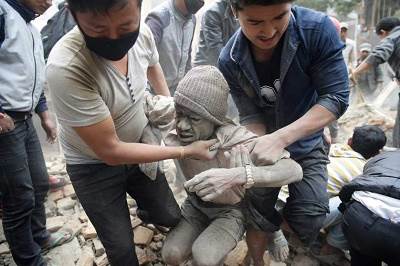Sleeping in the streets and shell-shocked, Nepalese cremated the dead and dug through rubble for the missing Sunday, a day after a massive Himalayan earthquake killed more than 2,200 people. Aftershocks tormented them, making buildings sway and sending panicked Kathmandu residents running into the streets.
“The aftershocks keep coming … so people don’t know what to expect,” said Sanjay Karki, Nepal country head for global aid agency Mercy Corps. “All the open spaces in Kathmandu are packed with people who are camping outdoors. When the aftershocks come you cannot imagine the fear. You can hear women and children crying.”
Saturday’s magnitude 7.8 earthquake spread horror from Kathmandu to small villages and to the slopes of Mount Everest, triggering an avalanche that buried part of the base camp packed with foreign climbers preparing to make their summit attempts. At least 17 people died there and 61 were injured.
The earthquake centered outside Kathmandu, the capital, was the worst to hit the South Asian nation in over 80 years. It destroyed swaths of the oldest neighborhoods of Kathmandu, and was strong enough to be felt all across parts of India, Bangladesh, China’s region of Tibet and Pakistan.
Read more: See the Most Dramatic Rescue From the Nepal Earthquake
By Sunday afternoon, authorities said at least 2,169 people had died in Nepal alone, with 61 more deaths in India and a few in other neighboring countries. At least 721 of them died in Kathmandu alone, and the number of injured nationwide was upward of 5,000. With search and rescue efforts far from over, it was unclear how much the death toll would rise.
But outside of the oldest neighborhoods, many in Kathmandu were surprised by how few modern structures — the city is largely a collection of small, poorly constructed brick apartment buildings — collapsed in the quake. While aid workers cautioned that many buildings could have sustained serious structural damage, it was also clear that the death toll would have been far higher had more buildings caved in.
Aid workers also warned that the situation could be far worse near the epicenter. The U.S. Geological Survey said the quake was centered near Lamjung, about 80 kilometers (50 miles) northwest of Kathmandu, in the Gorkha district.
Roads to that area were blocked by landslides, hindering rescue teams, said chief district official Prakash Subedi. Teams were trekking through mountain trails to reach remote villages, and helicopters would also be deployed, he said by telephone.
Local aid worker Matt Darvas said in a statement issued by his group, World Vision, that he heard that many remote mountain villages near the epicenter may have been completely buried by rock falls.
The villages “are literally perched on the sides of large mountain faces and are made from simple stone and rock construction,” Darvas said. “Many of these villages are only accessible by 4WD and then foot, with some villages hours and even entire days’ walks away from main roads at the best of times.”
Nepal’s worst recorded earthquake in 1934 measured 8.0 and all but destroyed the cities of Kathmandu, Bhaktapur and Patan.


And at that hour there was a great earthquake, and a tenth of the city fell. Seven thousand people were killed in the earthquake, and the rest were terrified and gave glory to the Elohim of heaven.
Condolences to the nation of Nepal.